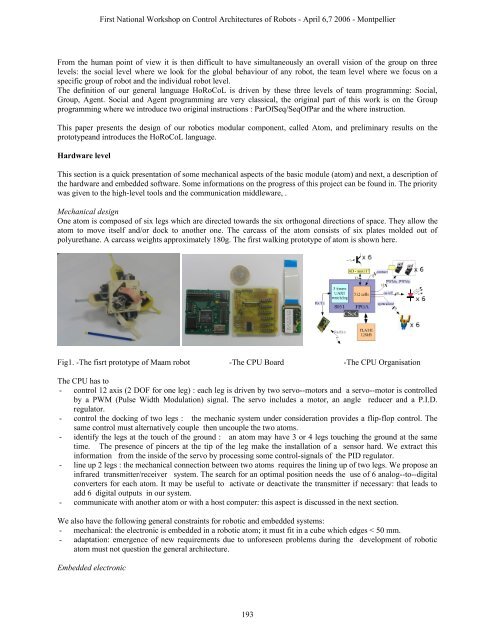Pleading for open modular architectures - Lirmm
Pleading for open modular architectures - Lirmm
Pleading for open modular architectures - Lirmm
Create successful ePaper yourself
Turn your PDF publications into a flip-book with our unique Google optimized e-Paper software.
From the human point of view it is then difficult to have simultaneously an overall vision of the group on three<br />
levels: the social level where we look <strong>for</strong> the global behaviour of any robot, the team level where we focus on a<br />
specific group of robot and the individual robot level.<br />
The definition of our general language HoRoCoL is driven by these three levels of team programming: Social,<br />
Group, Agent. Social and Agent programming are very classical, the original part of this work is on the Group<br />
programming where we introduce two original instructions : ParOfSeq/SeqOfPar and the where instruction.<br />
This paper presents the design of our robotics <strong>modular</strong> component, called Atom, and preliminary results on the<br />
prototypeand introduces the HoRoCoL language.<br />
Hardware level<br />
This section is a quick presentation of some mechanical aspects of the basic module (atom) and next, a description of<br />
the hardware and embedded software. Some in<strong>for</strong>mations on the progress of this project can be found in. The priority<br />
was given to the high-level tools and the communication middleware, .<br />
Mechanical design<br />
One atom is composed of six legs which are directed towards the six orthogonal directions of space. They allow the<br />
atom to move itself and/or dock to another one. The carcass of the atom consists of six plates molded out of<br />
polyurethane. A carcass weights approximately 180g. The first walking prototype of atom is shown here.<br />
Fig1. -The fisrt prototype of Maam robot -The CPU Board -The CPU Organisation<br />
The CPU has to<br />
- control 12 axis (2 DOF <strong>for</strong> one leg) : each leg is driven by two servo--motors and a servo--motor is controlled<br />
by a PWM (Pulse Width Modulation) signal. The servo includes a motor, an angle reducer and a P.I.D.<br />
regulator.<br />
- control the docking of two legs : the mechanic system under consideration provides a flip-flop control. The<br />
same control must alternatively couple then uncouple the two atoms.<br />
- identify the legs at the touch of the ground : an atom may have 3 or 4 legs touching the ground at the same<br />
time. The presence of pincers at the tip of the leg make the installation of a sensor hard. We extract this<br />
in<strong>for</strong>mation from the inside of the servo by processing some control-signals of the PID regulator.<br />
- line up 2 legs : the mechanical connection between two atoms requires the lining up of two legs. We propose an<br />
infrared transmitter/receiver system. The search <strong>for</strong> an optimal position needs the use of 6 analog--to--digital<br />
converters <strong>for</strong> each atom. It may be useful to activate or deactivate the transmitter if necessary: that leads to<br />
add 6 digital outputs in our system.<br />
- communicate with another atom or with a host computer: this aspect is discussed in the next section.<br />
We also have the following general constraints <strong>for</strong> robotic and embedded systems:<br />
- mechanical: the electronic is embedded in a robotic atom; it must fit in a cube which edges < 50 mm.<br />
- adaptation: emergence of new requirements due to un<strong>for</strong>eseen problems during the development of robotic<br />
atom must not question the general architecture.<br />
Embedded electronic<br />
First National Workshop on Control Architectures of Robots - April 6,7 2006 - Montpellier<br />
193

















